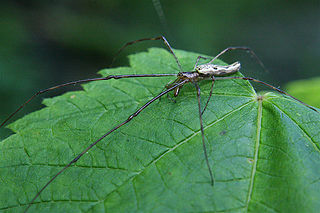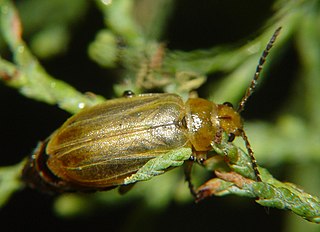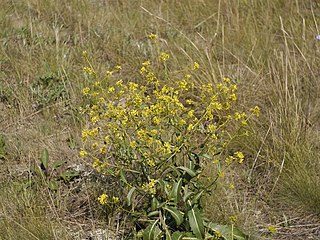
Armeria maritima, the thrift, sea thrift or sea pink, is a species of flowering plant in the family Plumbaginaceae. It is a compact evergreen perennial which grows in low clumps and sends up long stems that support globes of bright pink flowers. In some cases purple, white or red flowers also occur. It is a popular garden flower and has been distributed worldwide as a garden and cut flower. It does well in gardens designed as xeriscapes or rock gardens. The Latin specific epithet maritima means pertaining to the sea or coastal.

The elongated tortoise is a species of tortoise found in Southeast Asia and parts of South Asia.

Ulmus elongata, also known as the long raceme elm in the US, is a deciduous tree endemic to broadleaf forests in the eastern provinces of China.

The snaggletooth shark, or fossil shark, is a species of weasel shark in the family Hemigaleidae, and the only extant member of the genus Hemipristis. It is found in the Indo-West Pacific, including the Red Sea, from southeast Africa to the Philippines, north to China, and south to Australia, at depths from 1 to 130 meters. This shark can be found near the bottom of the water column of coastal areas, but can be found at continental and insular shelves. Its length is up to 240 cm (7.87 ft). Despite being only vulnerable to extinction, this shark is very rarely seen.
Hemipristis is a genus of weasel sharks, family Hemigaleidae. It contains one extant species, the snaggletooth shark and several extinct species.

The elongated shrew is a species of mammal in the family Soricidae. It is endemic to the island of Sulawesi in Indonesia. It lives in the forests of central, northern, and eastern Sulawesi from 200 to 2000 meters elevation.

Virola elongata is a species of tree in the family Myristicaceae. The tree is native to Panama, Guyana, Brazil, Bolivia, Colombia, Ecuador and Peru. It is also found in Suriname. Virola elongata is thin and 7.5–23 m (25–75 ft) tall, sometimes 30 m (98 ft) tall.

Tetragnatha elongata, the elongate stilt spider, is a spider in the family Tetragnathidae.

Mammillaria elongata, the gold lace cactus or ladyfinger cactus, is a species of flowering plant in the family Cactaceae, native to central Mexico. Growing to 15 cm (6 in) tall by 30 cm (12 in) wide, it consists of densely packed clusters of elongated oval stems, covered in harmless yellow or brown spines, and in spring producing white or yellow flowers. It is among the most common and most variable of its genus in nature, and is a popular subject for cultivation. It has gained the Royal Horticultural Society's Award of Garden Merit.

Diorhabda elongata is a species of leaf beetle known as the Mediterranean tamarisk beetle (MTB) which feeds on tamarisk trees from Portugal and Algeria east to southern Russia. The MTB is used in North America as a biological pest control agent against saltcedar or tamarisk, an invasive species in arid and semi-arid ecosystems.

Himanthalia elongata is a brown alga in the order Fucales, also known by the common names thongweed, sea thong and sea spaghetti. It is found in the north east Atlantic Ocean and the North Sea.
Cneoglossidae is a family of beetles in the superfamily Byrrhoidea, containing nine described species in a single genus, Cneoglossa, which are native to the Neotropics from Mexico to Brazil. The larvae develop inside rotting submerged branches found in small fast flowing shallow streams.
Ellobiopsis is a genus of unicellular, ectoparasitic eukaryotes causing disease in crustaceans. This genus is widespread and has been found infecting copepods from both marine and freshwater ecosystems. parasitism has been seen to interfere with fertility in both sexes of copepods.

Brassica elongata, the elongated mustard or long-stalked rape, is a species of the mustard plant that is native to parts of Central Europe, Eastern Europe, the Balkan Peninsula, the Caucasus, Morocco and parts of Central Asia. Through plant invasion this species has become naturalized in many other parts of the world. Some of these naturalized regions include South Africa, North Western Europe, Australia and North America. Given the wide range of climate and ecological conditions of these regions, B. elongata has been able to disrupt the ecosystems of their native plant habitats and has been label as an invasive species in many of its naturalized zones. In North America, this species is often found as a roadside weed in the southwestern states, particularly in the state of Nevada. Studies allude that the Cruciferae might have migrated through the Bering land bridge from what is now Central Asia. Commonly known as the long-stalked rape or as langtraubiger Kohl in German, this species is a close cousin to Brassica napus (rapeseed) and a secondary genetic relative to B. oleracea (kale). As a close genetic species of the rapeseed, the long-stalked rape has one of the highest counts of accumulated polyunsaturated linoleic and linolenic acid. Both compounds are heavily used to manufacture vegetable oils. Brassica elongata has the propagative potential of turning into a horticultural product from what is currently a noxious weed.

Cattleya elongata, the "cattleya with the elongated stalk", is an orchid species in the genus Cattleya endemic to the campo rupestre vegetation in northeastern Brazil.

The elongate ilisha, also known as the Chinese herring or slender shad, is a species of longfin herring native to the coastal waters and estuaries of North Indian Ocean and Northwest Pacific. It is a relatively large species, up to 45–60 centimetres (18–24 in) in total length. It is an important fishery species.
Leprodera verrucosa is a species of beetle in the family Cerambycidae. It was described by Francis Polkinghorne Pascoe in 1866. It is known from Sumatra and Borneo.

Paraleprodera insidiosa is a species of beetle in the family Cerambycidae. It was described by Francis Polkinghorne Pascoe in 1888, originally under the genus Leprodera. It is known from India, Myanmar, Malaysia, Laos, Taiwan, Cambodia, and Thailand. It contains the varietas Paraleprodera insidiosa var. unimaculata.

Amanita elongata or Peck's yellow dust amanita is a species of Amanita from Northeastern United States and Canada.

Paraleptopentacta elongata is a species of sea cucumber in the family Cucumariidae. It is found in the northeastern Atlantic Ocean and parts of the Mediterranean Sea. It is an infaunal species, occupying a burrow in the seabed, from which its anterior and posterior ends project.















